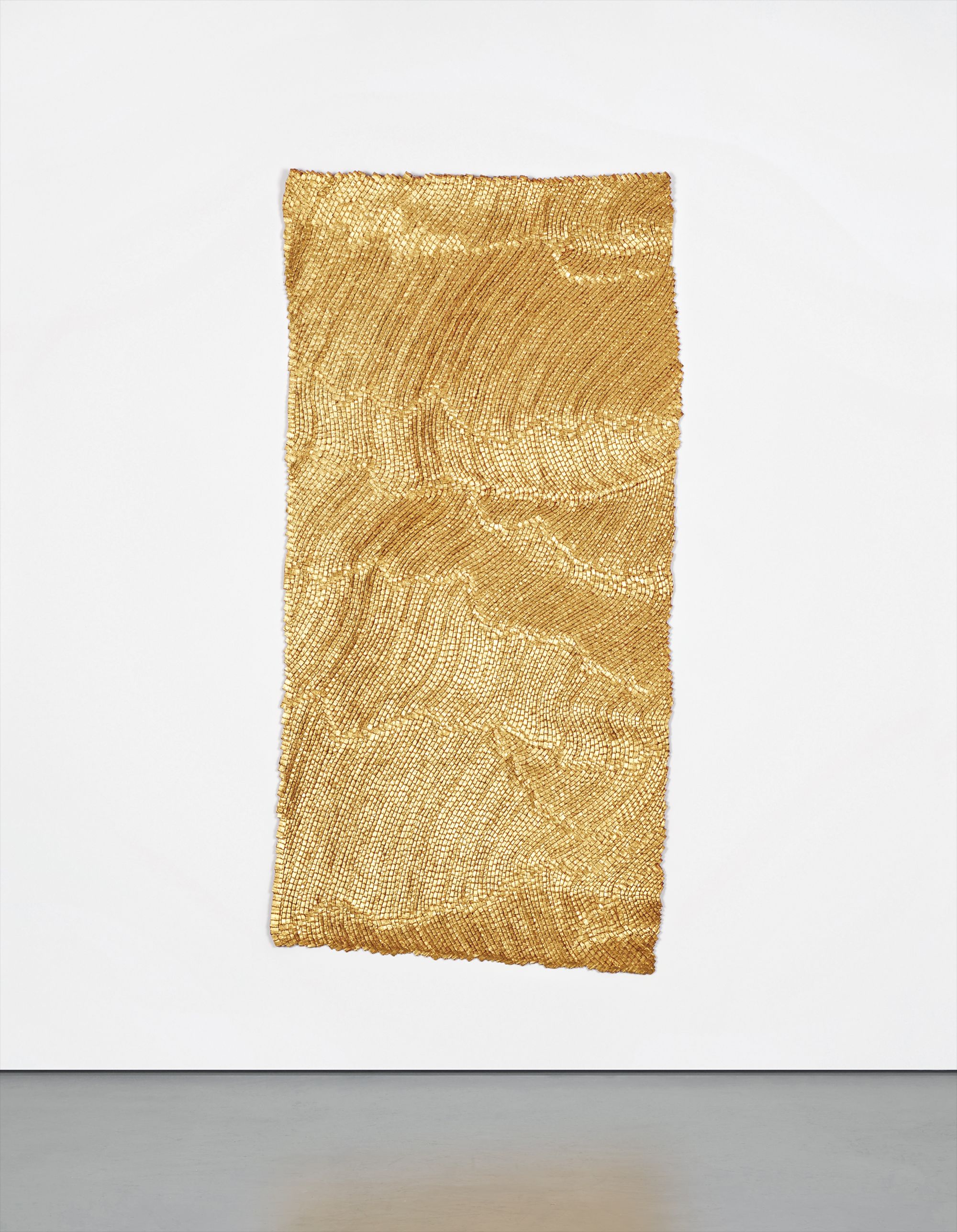



8
Olga de Amaral
Umbra B
Full-Cataloguing
De Amaral received a formal education at Cranbrook Academy in Michigan, which she coupled with an acute knowledge of textiles gathered from her extensive travels. She thus obtained an invaluable, practical knowledge in the art of weaving from different cultures around the world. One of the most influential textiles for de Amaral was Andean weaving techniques from Peru. This technique informed her most important period of gold and silver textiles. During this mature period within her oeuvre, de Amaral began using strips of textured linen and braiding threads that she coated with paint as well as gold and silver leaf. This preparation of textured linen constitutes arduous manual work that takes a significant amount of time, and ultimately results in the astounding compact geometric repetitions and ravishing patterns for which she is well known. More importantly, these intricate patterns also pose an ongoing question that is faced by painters: the matter of how to deal with superposition and layering. These techniques, typically utilized by painters, help capture light in a canvas and add depth to a work of art. Olga de Amaral brilliantly applies this basic principle to her work by superimposing layers of thread in her textiles. She began experimenting with layering very early on in her career, as seen in works as early as Entrelazado en naranja, gris, multicolor (1969) and reflected later in her Lienzo ceremonial 5 (1989). In these two examples de Amaral hand braided threads over woven threads in a loom, which created an “aerial interplay of light, [and] an unstable surface plane” as aptly stated by Jacques Leenhardt (J. Leenhardt, Olga de Amaral – The Mantle of Memory, Amaral Editores, Colombia, 2013, p. 174).
This experimentation in layering later culminated with the use of gold leaf, which ultimately gave her works a sculptural depth in addition to capturing light. The interlacing in her weavings became much more complex and the texture became denser adding dimensionality, clearly emulated in the present lot. This dense texture was also produced by the incorporation of gesso, used in the application of the gold leaf, creating sophisticated patterns. These curves create a wave-like pattern that is reminiscent of Japanese textiles produced between the fourteenth and early seventeenth century, which were considered prime examples of the height of creativity and beauty during the Edo period, a booming economic and artistic period in the history of Japan.
This radiant work not only delineates her deep understanding of the history of textiles, but also transcends the boundaries of conventional weaving techniques. She accomplishes this by introducing into her works fine art principles of abstraction, pictorialism and geometric rigor, all strategies found in painting and sculpture. In doing this, she has placed herself at the forefront of Contemporary Art. Thus, as Heather Corcoran aptly states, her works can be seen as “multimedia fiber works that are neither canvases nor tapestries. They look like artifacts from an ancient age, but steeped in the modern tradition of abstraction” (H. Corcoran, Olga de Amaral, Editions Agnés Monplaisir, Paris, 2015, p. 4). De Amaral's importance is confirmed by the fact that her work has been extensively exhibited internationally at institutions, including the Museum of Modern Art, New York and the Metropolitan Museum of Art, New York.
Olga de Amaral
Colombian | 1932At age 22 with a degree in architectural design, Olga de Amaral moved from Bogotá to the United States where she studied fiber art at the Cranbrook Academy of Art in Michigan. She returned to Colombia in 1955, and in 1956 she and her husband, Jim Amaral, opened a workshop of hand-woven textiles. De Amaral's distinctive large-scale abstract woven pieces are often covered in gold and silver leaf, lending them a shimmering, almost sculptural quality in contrast to the feeling of a tapestry. Her richly textured pieces evoke the varied natural landscapes of Colombia as well as ancient pre-Columbian gold artifacts. The artist's architectural background is evident in the precise sculptural quality of her works, but de Amaral says her craft is driven by emotion and that she does not plan for particular patterns to emerge.